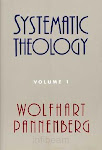This is an essay on the nature of doctrine. References are to Jaroslav Pelikan’s monographs on the development of Christian doctrine. Reference (3:241) would refer to volume 3, page 241.
1. Doctrine is “important”
2. Doctrine and mystery
3. The inadequacy of doctrine
4. The inevitability of doctrine
5. The scope of doctrine
6. “Hierarchies” of doctrine
7. The relation of words and reality
8. Liturgy as the fulfillment of doctrine
9. Love as the fulfillment of doctrine
-- -- --
Doctrine and Mystery
Doctrines seek to express and clarify what the church “believes, teaches, and confesses” to both its members (the faithful) and to non-members.
Doctrines should, ideally, support and guide the faithful in life, both in worship (vertical relationship) and in morals (horizontal relationship). Alterations in doctrine result in alterations in worship and morality, for better or for worse.
In this way doctrine serves as a kind of “theological map”, to use C. S. Lewis’s analogy: alterations in the accuracy of the map pertain to the sailor’s ability (or inability) to sail from harbor to harbor through seas and oceans, not only safely but also “splendidly”, if you will.
Doctrine relates to mystery. The character of their relation is at the heart of this article series. Because this relation is to some extent itself a mystery, various expressions have been suggested to capture it.
Maximus said that “dogma” (in this case of salvation as deification) “belongs to the mystery of the faith” (2:30), and doctrines were “the articulation of the mystery of truth” (2:36). According to Harnack dogmas are “doctrines of faith, formulated in concepts” and these “comprehend the knowledge of God” and present “the objective content of religion” (5:268). Erigena said that theology, understood as road to doctrine, was “human investigations” of mystery, the deep things of God (3:99), that is, “the investigation of the divine essence” (3:100).
But formulating doctrine, in other words articulating the mystery, requires the locating of the mystery first. It implies the obligation to recognize that “this is a mystery”, and then “to know it”, as Werenfels put it (3:67). This is no easy task.
Some mysteries appear more frequently among the lists of “principle mysteries of faith”. Francke regarded the problem of evil as a “mystery”; for Sturza the resurrection of the body was an “unfathomable mystery”; Scriver saw the doctrine of predestination as a “heavenly mystery”; the economy of the incarnation was a “great mystery”, said Zinzendorf; and, according to Burnet, it is above all to “the mystery of Christ upon the cross” and to Christ’s mysterious cry of dereliction that faith turned (5:67-68).
Yet of all the mysteries of the faith, the dogma of the Triune God has been, by ecumenical consent, the most fundamental and the most “sublime mystery” (5:68) -- although so-called Unitarians have (happily) dropped it.
2 years ago







No comments:
Post a Comment